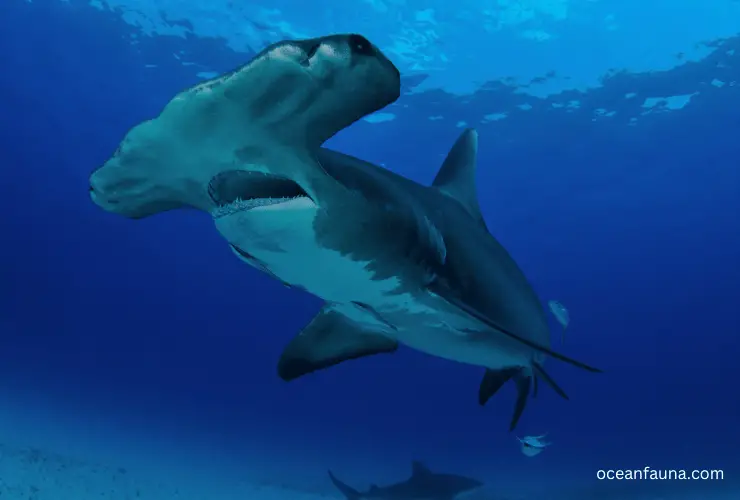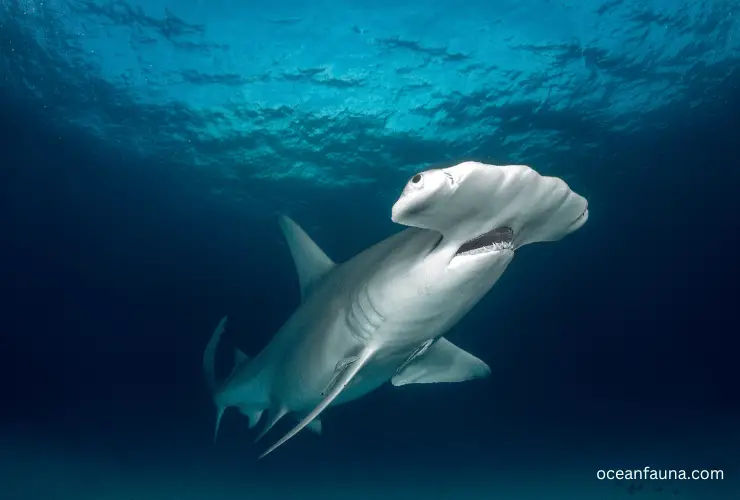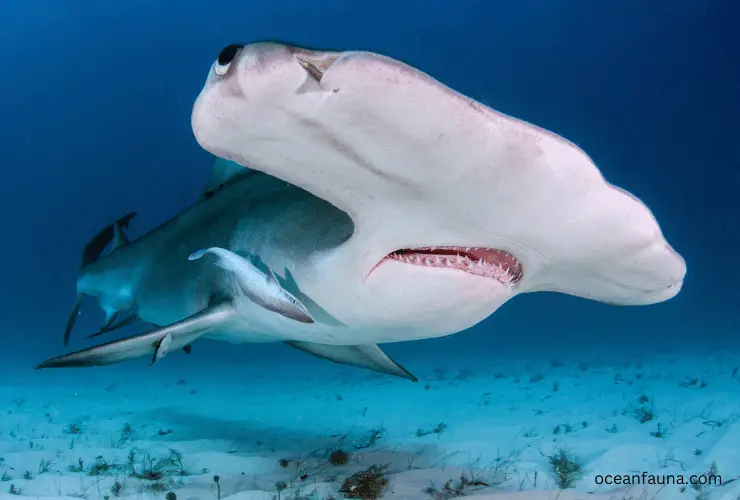In movies and animation, you might see the hammerhead shark depicted with its head shape looking like a literal hammer – but in reality, the head of a hammerhead shark is more curved than it looks.
So, why do hammerhead sharks have hammer-shaped heads?
Well, the scientific purpose of this unique shape is to maximize the shark’s ability to detect prey. In this article, I will go into more detail regarding this matter.
Why Do Hammerhead Sharks Have Hammer-Shaped Heads?
The hammerhead sharks are one of the most recognizable species in the world due to their unique and distinctive head shape, which resembles a hammer. While this head shape may look odd, it is actually an extremely beneficial adaptation that gives them several advantages over other shark species.
First and foremost, the hammerhead’s wide head gives its eyes a better range of vision thanks to its two separate eyes located at either end of the head. This allows hammerhead sharks to see both above and below them at the same time, allowing them to spot potential prey, even if it is hiding or camouflaged.
Secondly, this wide head also facilitates the movement of water across their field of vision which helps them detect small vibrations created by potential prey from farther away than other sharks can. The width also allows for an increase in electrical sensitivity along their flanks and pressure sensitivity along their heads, which helps when trying to locate hidden prey.
The hammerhead’s unique head shape also provides another advantage: it increases maneuverability in tight spaces such as coral reefs where other sharks might have trouble maneuvering. The shape creates a wider turning circle for these sharks, making it easier for them to turn quickly and efficiently so they can better evade predators or pursue prey with ease.

Additionally, because their bodies are slightly flattened on top and bottom, these sharks have more hydrodynamic efficiency than other shark species allowing them to swim faster while expending less energy.
Overall, Hammerhead Sharks’ impressive adaptations give them a competitive edge over other species in terms of hunting and avoiding predators, all thanks to their iconic hammer-shaped heads!
Are Hammerhead Sharks Real?
Yes, hammerhead sharks are a real species of shark, belonging to the family Sphyrnidae and found in tropical and subtropical waters around the world, especially near coral reefs. They have a unique physical appearance, featuring an unusually broad, flattened head that resembles a hammer or shovel.
This gives them increased maneuverability and sensory perception as they hunt prey in shallow water. Hammerhead sharks can grow up to 6 meters in length and weigh up to 570 kilograms.
These sharks can live for around 20-25 years in captivity, but their life expectancy is likely much lower in the wild due to predation by larger species of sharks like the great white shark.
Hammerhead sharks are also threatened by overfishing and habitat loss due to coastal development. As apex predators, they play an important role in maintaining healthy marine ecosystems.
They typically feed on smaller fish species such as sardines, anchovies, and other small bony fishes, squid, and octopus.
In some cases, they may feed on larger sea turtles or scavenge for carrion on the ocean floor. Some species of hammerhead sharks have been observed forming large aggregations of hundreds of individuals at certain times of the year, usually during mating season or when food is abundant.
How Do Hammerhead Sharks Capture Their Prey?
Hammerhead sharks employ a variety of hunting techniques, depending on their prey. For example, they may use their wide, flat heads to sweep the ocean floor for hidden prey when hunting for fish. This technique is especially effective in shallow waters where hammerhead sharks have the advantage of being able to see a larger area of the seafloor.
When hunting smaller prey, such as crustaceans or squid, hammerheads often use a “ram feeding. technique,” which involves swimming rapidly toward the prey and turning just before impact to swallow it whole using suction.
Hammerheads also rely on their unique sensory organs, known as ampullae of Lorenzini, to detect the electrical signals projected by concealed prey to locate them precisely.
In addition to these two commonly observed techniques, there is evidence that hammerhead sharks may sometimes hunt cooperatively with other species of sharks or even other marine creatures like dolphins and sea turtles. They can increase their efficiency in locating and capturing food by working together.
Hammerheads are relentless hunters and exhibit an impressive range of predatory strategies; they actively forage both during the day and night, using their maneuverability, agility, and keen senses to swiftly capture small fish, crustaceans, cephalopods – even some that may be difficult to spot. Their remarkable hunting skills ensure they never go hungry!
Has a Hammerhead Ever Attacked a Human?
Hammerhead sharks, which belong to the Sphyrna, are large, distinctive-looking predators ranging in size from around 3 feet to more than 20 feet.
Hammerheads may be intimidating and predatory, but they typically pose little threat to humans. Over the past five centuries, there have been 17 non-fatal reported unprovoked attacks by hammerhead sharks in total, according to The International Shark Attack File – much less compared to other species of sharks.
These attacks were mostly minor bites or bumps against people swimming or surfing in shallow waters near shore. Out of all these attacks reported, none were fatal; however, they remain a potential danger to those at risk of interacting with them in the wild.
The majority of incidents involving hammerheads are actually due to human activity; shark fishing has become increasingly popular in some parts of the world, and as a result, more sharks may be coming into contact with humans than before.
Furthermore, hammerhead populations are reaching dangerously low levels due to an increase in demand for their meat and fins; this is further endangering both sharks and people as they can be accidentally caught in fishing nets meant for other species or mistaken for another edible fish.
Remember that while hammerheads should not be considered harmless creatures by any means, they rarely pose any direct threat to human swimmers or divers if given space and respected from a distance.
People should be aware that they represent apex predator that plays an essential role in maintaining balance within marine ecosystems; protecting them will help ensure their survival and reduce the risk of potentially dangerous encounters between humans and sharks.
Can Hammerhead Sharks See 360?
Hammerhead Sharks are a fascinating species of sharks, with one of their most interesting features being the shape of their head. These incredible animals possess an extended or hammer-shaped head known as the cephalofoil. This unique feature allows them to have a very wide field of vision which can be up to 360 degrees, depending on the species.
This means that they are able to see in all directions at once and don’t miss out on any potential food sources or other opportunities. The great hammerhead shark has even been recorded as having the widest visual field of all shark species at 270 – 300 degrees.

Other species possess fields between 180-270 degrees, while some, such as the scalloped hammerhead, have 270-360 degree vision capabilities.
This advanced eye structure is incredibly advantageous for these apex predators as it gives them an unparalleled advantage when hunting prey items or searching for food sources in their environment.
This enhanced vision provides them with a larger area to find potential meals and increases safety by allowing them to keep an eye out for any approaching threats from all angles.
What’s even more impressive is that some species possess overlapping visual fields behind themselves that can reach up to full 360-degree vision! This means that no matter where something may be swimming behind them, they will still be able to spot it due to the overlapping visual fields making for exceptional awareness and agility in a situation where quick reactions are necessary.
What Obstacles and Threats Do Hammerhead Sharks Face Due To Their Distinctive Head Shape?
Hammerhead sharks face a number of challenges caused by their unique head shape. The most significant issue is the problem of hydrodynamic drag, which has been observed to be higher in hammerheads than in other sharks due to their wide heads and narrow bodies. This increased drag reduces the speed and maneuverability of hammerheads, making them less adept at hunting prey.
Additionally, the wide-set eyes of hammerhead sharks may reduce their depth perception and make it more difficult for them to gauge distances accurately.
A further issue is that the wide head shape of hammerheads also increases their surface area exposure to predators, leaving them more vulnerable than other shark species in certain environments.
Hammerheads are also unable to burrow into the sediment like other species due to their head shape – a common defensive tactic used by sharks – which further limits their ability to escape danger or surprise prey.
The unique arrangement of sensory organs on a hammerhead’s head has also been linked with several potential disadvantages.
Research suggests that having such sensitive receptors scattered across its wide head may actually reduce the overall ability of a hammerhead shark to detect potential threats or prey, as they are spread out over a larger area than in other species.
Similarly, having too many electroreceptors can create “noise,” which interferes with an individual’s ability to identify prey clearly.
Finally, increased competition from other animals for food resources due to their wide head has been suggested as another problem associated with a hammerhead’s anatomy – though further research is needed on this topic before any definitive conclusions can be reached.
Conclusion
Hopefully, you understand what benefits a hammerhead shark poses due to its unique head shape. It has a wide visual field which provides them with an unparalleled advantage when hunting for prey and improved awareness and agility in dangerous situations.
However, the same features can also create some problems for the species, such as reduced speed and maneuverability, reduced depth perception, increased surface area exposure to predators, and decreased ability to detect potential threats or prey.
Despite these challenges, hammerhead sharks remain apex predators in their environments and continue proving why they are so iconic!


9 thoughts on “Why Do Hammerhead Sharks Have Hammer-Shaped Heads?”